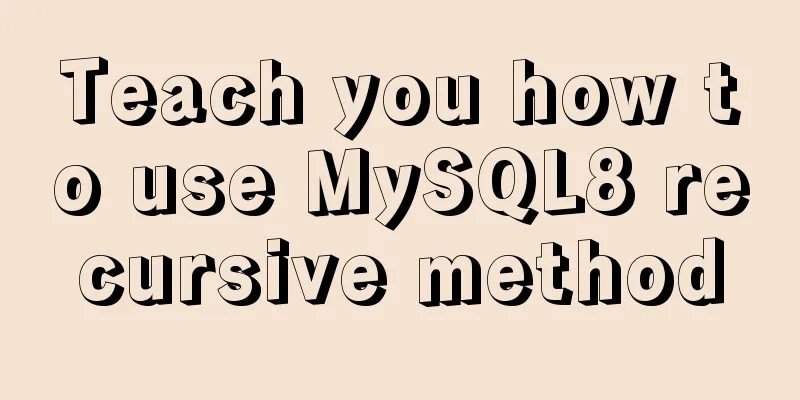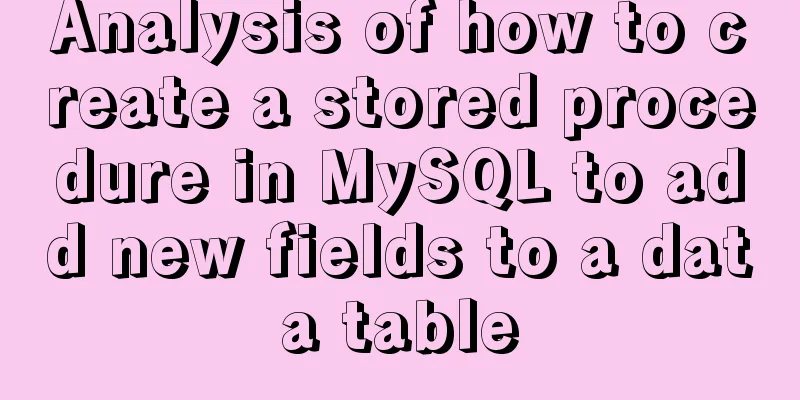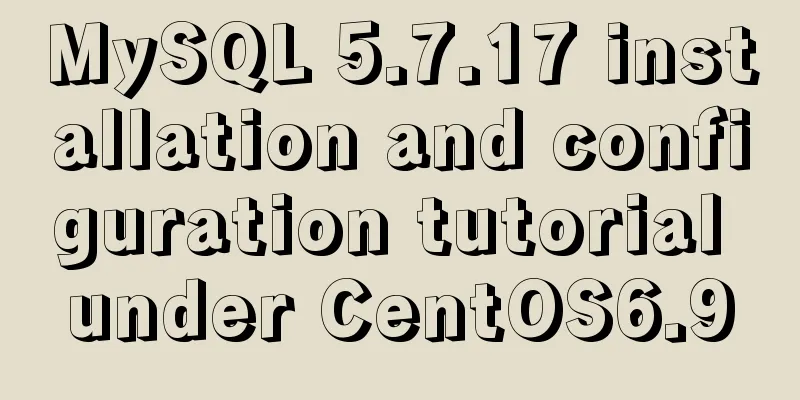Teach you how to use MySQL8 recursive method

|
I have previously written an article about recursive querying tree structures in MySQL using custom functions. Since MySQL 8.0, recursive query syntax has finally been supported. CTE First, let's understand what CTE is. The full name is Common Table Expressions WITH cte1 AS (SELECT a, b FROM table1), cte2 AS (SELECT c, d FROM table2) SELECT b, d FROM cte1 JOIN cte2 WHERE cte1.a = cte2.c; cte1, cte2 are the CTEs we defined, which can be referenced in the current query It can be seen that CTE is a temporary result set, similar to a derived table. The difference between the two is not explained in detail here. You can refer to the MySQL development documentation: https://dev.mysql.com/doc/refman/8.0/en/with.html#common-table-expressions-recursive-examples Recursive query Let's first look at the syntax of recursive queries. WITH RECURSIVE cte_name AS ( SELECT ... -- return initial row set UNION ALL / UNION DISTINCT SELECT ... -- return additional row sets ) SELECT * FROM cte;
The recursive part cannot include:
The above explanation may be a bit abstract, so let’s slowly understand it through examples. WITH RECURSIVE cte (n) AS -- The n defined here is equivalent to the column name of the result set, which can also be defined in the following query ( SELECT 1 UNION ALL SELECT n + 1 FROM table WHERE n < 5 ) SELECT * FROM cte; --result +------+ | n | +------+ | 1 | | 2 | | 3 | | 4 | | 5 | +------+
EXAMPLE Finally, let's look at an example of a tree structure. CREATE TABLE `c_tree` ( `id` int(11) NOT NULL AUTO_INCREMENT, `cname` varchar(255) COLLATE utf8mb4_unicode_ci DEFAULT NULL, `parent_id` int(11) DEFAULT NULL, PRIMARY KEY (`id`) ) ENGINE=InnoDB AUTO_INCREMENT=13 DEFAULT CHARSET=utf8mb4 COLLATE=utf8mb4_unicode_ci; mysql> select * from c_tree; +----+---------+-----------+ | id | cname | parent_id | +----+---------+-----------+ | 1 | 1 | 0 | | 2 | 2 | 0 | | 3 | 3 | 0 | | 4 | 1-1 | 1 | | 5 | 1-2 | 1 | | 6 | 2-1 | 2 | | 7 | 2-2 | 2 | | 8 | 3-1 | 3 | | 9 | 3-1-1 | 8 | | 10 | 3-1-2 | 8 | | 11 | 3-1-1-1 | 9 | | 12 | 3-2 | 3 | +----+---------+-----------+ mysql> WITH RECURSIVE tree_cte as ( select * from c_tree where parent_id = 3 UNION ALL select t.* from c_tree t inner join tree_cte tcte on t.parent_id = tcte.id ) SELECT * FROM tree_cte; +----+---------+-----------+ | id | cname | parent_id | +----+---------+-----------+ | 8 | 3-1 | 3 | | 12 | 3-2 | 3 | | 9 | 3-1-1 | 8 | | 10 | 3-1-2 | 8 | | 11 | 3-1-1-1 | 9 | +----+---------+-----------+
More information https://dev.mysql.com/doc/refman/8.0/en/with.html The above is the full content of this article. I hope it will be helpful for everyone’s study. I also hope that everyone will support 123WORDPRESS.COM. You may also be interested in:
|
<<: A complete record of the process of building mobile applications using Vue Native
Recommend
In-depth explanation of the style feature in Vue3 single-file components
Table of contents style scoped style module State...
Detailed tutorial on installing pxc cluster with docker
Table of contents Preface Preliminary preparation...
Detailed explanation of the problem of CSS class names
The following CSS class names starting with a num...
About Zabbix custom monitoring items and triggers
Table of contents 1. Monitoring port Relationship...
How to configure NAS on Windows Server 2019
Preface This tutorial installs the latest version...
Vue implements two routing permission control methods
Table of contents Method 1: Routing meta informat...
Detailed explanation of MySQL master-slave database construction method
This article describes how to build a MySQL maste...
How to quickly build an FTP file service using FileZilla
In order to facilitate the storage and access of ...
In-depth study of JavaScript array deduplication problem
Table of contents Preface 👀 Start researching 🐱🏍...
Detailed explanation of MySQL Workbench usage tutorial
Table of contents (I) Using Workbench to operate ...
MySQL detailed summary of commonly used functions
Table of contents MySQL Common Functions 1. Numer...
Detailed explanation of viewing and setting SQL Mode in MySQL
Viewing and Setting SQL Mode in MySQL MySQL can r...
Brief analysis of MySQL union and union all
In the database, both UNION and UNION ALL keyword...
Detailed explanation of Apache SkyWalking alarm configuration guide
Apache SkyWalking Apache SkyWalking is an applica...
How to change the character set encoding to UTF8 in MySQL 5.5/5.6 under Linux
1. Log in to MySQL and use SHOW VARIABLES LIKE &#...









